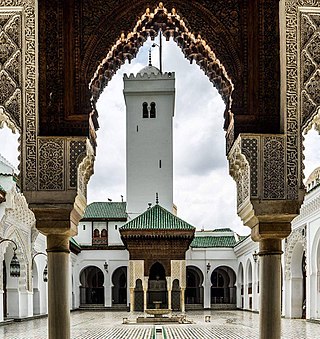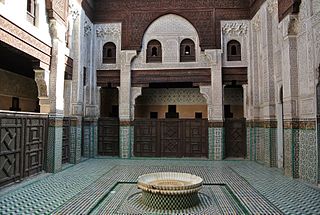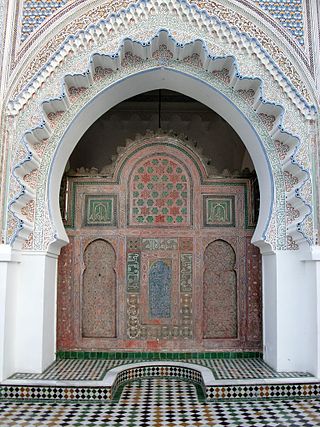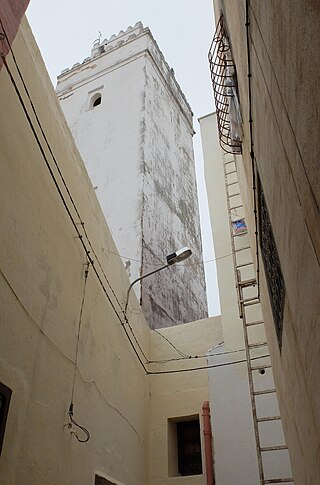
The University of al-Qarawiyyin, also written Al-Karaouine or Al Quaraouiyine, is a university located in Fez, Morocco. It was founded as a mosque by Fatima al-Fihri in 857–859 and subsequently became one of the leading spiritual and educational centers of the Islamic Golden Age. It was incorporated into Morocco's modern state university system in 1963 and officially renamed "University of Al Quaraouiyine" two years later. The mosque building itself is also a significant complex of historical Moroccan and Islamic architecture that features elements from many different periods of Moroccan history.

The Saadian Tombs are a historic royal necropolis in Marrakesh, Morocco, located on the south side of the Kasbah Mosque, inside the royal kasbah (citadel) district of the city. They date to the time of the Saadian dynasty and in particular to the reign of Ahmad al-Mansur (1578–1603), though members of Morocco's monarchy continued to be buried here for a time afterwards. The complex is regarded by many art historians as the high point of Moroccan architecture in the Saadian period due to its luxurious decoration and careful interior design. Today the site is a major tourist attraction in Marrakesh.

The Bou Inania Madrasa is a historic madrasa in the city of Meknes, Morocco. The building, well-preserved thanks to later restorations, is considered an excellent example of the richly-decorated madrasas of the Marinid period.

Moorish architecture is a style within Islamic architecture which developed in the western Islamic world, including al-Andalus and what is now Morocco, Algeria, and Tunisia. Scholarly references on Islamic architecture often refer to this architectural tradition in terms such as architecture of the Islamic West or architecture of the Western Islamic lands. The use of the term "Moorish" comes from the historical Western European designation of the Muslim inhabitants of these regions as "Moors". Some references on Islamic art and architecture consider this term to be outdated or contested.

'Anaza or anaza refers to a short spear or staff that held ritual importance in the early period of Islam. The term gained significance after the Islamic prophet Muhammad planted his spear in the ground to indicate the direction of prayer (qibla). Over time, 'anaza evolved into an architectural term denoting an outdoor mihrab in mosques, particularly in the Maghreb region.

The Great Mosque of Taza is the most important religious building in the historic medina of Taza, Morocco. Founded in the 12th century, it is the oldest surviving example of Almohad architecture, although it was expanded by the Marinids in the late 13th century.

The Bou Inania Madrasa or Bu 'Inaniya Madrasa is a madrasa in Fes, Morocco, built in 1350–55 CE by Abu Inan Faris. It is the only madrasa in Morocco which also functioned as a congregational mosque. It is widely acknowledged as a high point of Marinid architecture and of historic Moroccan architecture generally.

The Al-Attarine Madrasa or Medersa al-Attarine is a madrasa in Fes, Morocco, near the Al-Qarawiyyin Mosque. It was built by the Marinid sultan Uthman II Abu Said in 1323-5. The madrasa takes its name from the Souk al-Attarine, the spice and perfume market. It is considered one of the highest achievements of Marinid architecture due to its rich and harmonious decoration and its efficient use of limited space.

The Mosque of the Andalusians or Al-Andalusiyyin Mosque, sometimes also called the Andalusian Mosque, is a major historic mosque in Fes el Bali, the old medina quarter of Fez, Morocco. The mosque was founded in 859–860, making it one of the oldest mosques in Morocco. It is located at the heart of a district which was historically associated with Andalusi immigrants, from which it takes its name. It has been renovated and expanded several times since then. Today, it is one of the relatively few remaining Idrisid-era establishments and one of the main landmarks of the city.

Saffarin Madrasa is a madrasa in Fes el-Bali, the old medina quarter of Fez, Morocco. It was built in 1271 CE by the Marinid Sultan Abu Ya'qub Yusuf and was the first of many madrasas built by the Marinid dynasty during their reign. It is located just south of the 9th-century Qarawiyyin Mosque on Saffarin Square, which is named after the coppersmiths who work in the square.

The Royal Palace or Dar al-Makhzen is the palace of the King of Morocco in the city of Fez, Morocco. Its original foundation dates back to the foundation of Fes el-Jdid, the royal citadel of the Marinid dynasty, in 1276 CE. Most of the palace today dates from the 'Alawi era. The vast grounds are home to multiple private structures, patios, and gardens, but historically also included administrative offices and government tribunals. Today, the most publicly visible parts of the palace are its main entrances at the Old Mechouar and the highly ornate 20th-century gates at Place des Alaouites, near the Mellah.

The architecture of Fez, Morocco, reflects the wider trends of Moroccan architecture dating from the city's foundation in the late 8th century and up to modern times. The old city (medina) of Fes, consisting of Fes el-Bali and Fes el-Jdid, is notable for being an exceptionally well-preserved medieval North African city and is classified as a UNESCO World Heritage Site. A large number of historic monuments from different periods still exist in it today, including mosques, madrasas, synagogues, hammams (bathhouses), souqs (markets), funduqs (caravanserais), defensive walls, city gates, historic houses, and palaces.

Cherratine Madrasa is an Islamic school or madrasa that was built in 1670 by the Alawi sultan Moulay al-Rashid. It is located in the city of Fez in Morocco. The madrasa is also called Er-Rachidia Madrasa or Ras al-Cherratine Madrasa.

The Grand Mosque of Meknes is the historic main mosque of the old city (medina) of Meknes, Morocco. It is the largest and most important mosque in the old city and one of its oldest monuments.

The Bou Jeloud Mosque is a historic Almohad-era mosque in the former Kasbah of Bou Jeloud, located near Bab Bou Jeloud, in Fes, Morocco.

The al-Hamra Mosque or Red Mosque is a Marinid-era mosque in Fes, Morocco. It is a local Friday mosque located on the Grande Rue of Fes el-Jdid, the palace-city founded by the Marinid rulers.

The Lalla ez-Zhar Mosque, or al-Zahr Mosque, is a mosque located in Fes el-Jdid in the historic old city of Fez, Morocco. It is also known by the name Jama’ el-Hajjar, probably in reference to its stone portal entrance. The mosque was founded or completed in 1357 CE by the Marinid sultan Abu Inan.

The Lalla Aouda Mosque or Mosque of Lalla 'Awda is a large historic mosque in Meknes, Morocco. It was originally the mosque of the Marinid kasbah (citadel) of the city, built in 1276, but was subsequently remodeled into the royal mosque of the Alaouite sultan Moulay Isma'il's imperial palace in the late 17th century.

The Zawiya of Sidi Bel Abbes or Zaouia of Sidi Bel-Abbès is an Islamic religious complex (zawiya) in Marrakesh, Morocco. The complex is centered around the mausoleum of Abu al-Abbas as-Sabti, a Sufi teacher who died in 1204. He is the most venerated of the Seven Saints of Marrakesh, generally considered the "patron saint" of the city. The zawiya's architecture dates in part to the late Saadian period but has been modified and restored multiple times since then.
The Madrasa of Fes el-Jdid, also known as the Madrasa of Dar al-Makhzen, was a 14th-century madrasa built by the Marinid dynasty in the Fes el-Jdid quarter of Fez, Morocco. The madrasa was later converted into a mosque and integrated into the expanded Dar al-Makhzen of Fez, where it is still standing today.
























